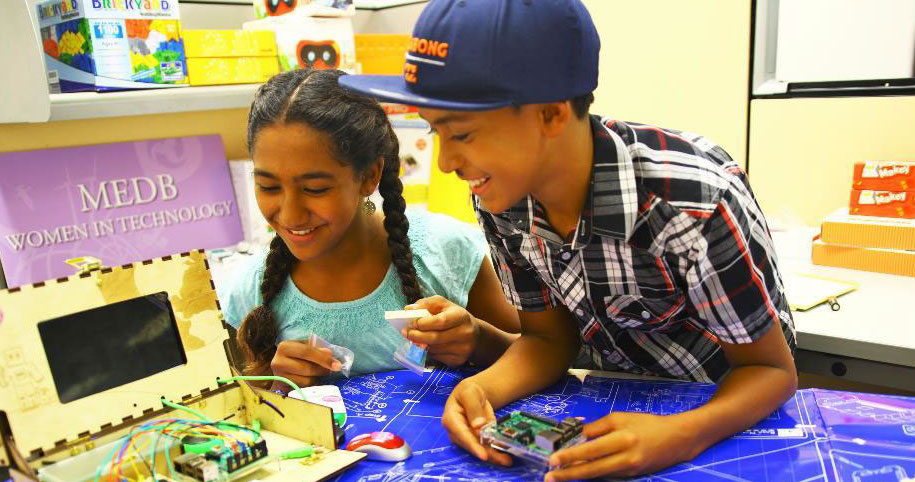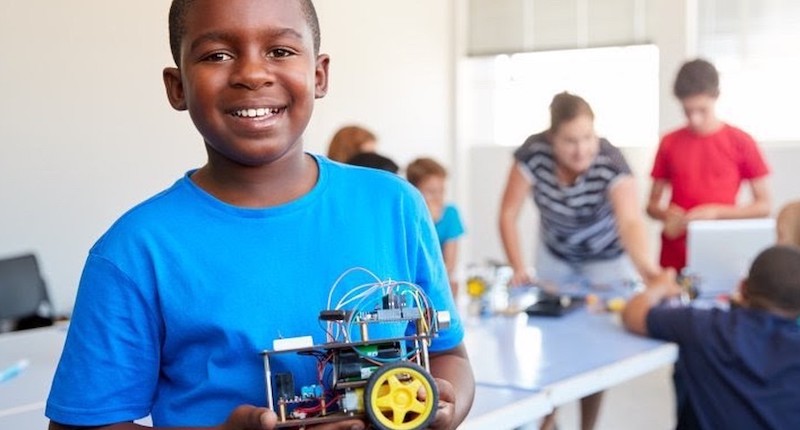Education in the 21st century, especially when educational technology plays a role, very much aligns with progress, growth, and the scaling of programs. Now that the summer is here, we're talking about some of the programs students take part in outside of the classroom, including afterschool programs. Many kids participate only because their parents need a place for them to go until they're done working. Realistically, this might mean children are not doing anything meaningful while there. If an afterschool leader—whether they’re affiliated with a school or not—are looking to provide more relevant experiences for kids, they can start with programs that involve STEM and EdTech tools. This helps kids build on all achievements until education leaders can start scaling STEM in a more sustainable way.
A Continued Need for Scaling STEM After School
Innovative afterschool programs don’t necessarily need to focus on EdTech, but it would be ideal if children have the opportunity to be challenged with or without technology. Many afterschool programs, however, do focus on teaching kids coding skills, which is great! On the other hand, others align more with helping them boost some of their key soft skills, like communication and collaboration. Still others are simply for helping them unleash their creativity in a productive way. Whatever the case might be, the educators or counselors who are present for these afterschool programs should be assessing what works well and what elements might be worth revisiting. Out-of-school time is critical for children and the programming that's available to them can help in their STEM, personal, and academic development.
One common proposal for programming is in the form of computer science activities. We love this (partially because we spend most of our time promoting the importance of STEAM education and coding). But it’s often tough on educational leaders or camp directors to make afterschool computer science experiences a reality. We know the job market, however, and jobs in STEM and computer science are always high. This leads us to continue to promote teaching coding after school. And, that’s another big thing. Many children can't practice coding in school or only have a brief window. Others miss out on opportunities for hands-on coding if there’s not time. This can make the option of teaching coding after school more appealing. There are also plenty of ways to build a sustainable computer science program while scaling STEM initiatives.
Without an opportunity to explore STEAM in-depth during the school day, many students lose interest at a younger age. Afterschool STEM programs may help generate interest, especially among students who are statistically underrepresented in STEM professions. Students sometimes can make excuses or believe they aren't smart enough for a STEAM career. They also can feel outnumbered (this is especially true for women and minority groups). Afterschool programs can be a way for educators to show kids that STEM education is 100 percent inclusive. So, whether it’s to keep them busy, keep them engaged with learning, help close any learning gaps, or to reaffirm a commitment to preparing them for a STEM-related future, afterschool STEM programs can help fill various needs. It's getting them off the ground, however, that often presents the greatest challenge.
Afterschool Programs Help Foster Inclusion
Over the last year, the topic of inclusion has been a huge one in the education world. Starting with what we saw with this shift to remote learning, we learned that, oftentimes, inclusion and equity just aren't universal. And, as unfortunate and disheartening as it is, it’s true in education also. Certain students might sometimes receive exciting opportunities to take part in various programs—something that’s true in general and true in various STEAM subjects as well. Education leaders can use afterschool programming, however, to create a better environment for all students. Ideally, it can center on inclusion and advancing everyone’s abilities.
For an afterschool program to help build as much inclusion as possible, it needs to be sustainable. So, the more sustainable it is and the longer it operates for, the more opportunities there are for the children. Some education program experts have outlined important factors for ensuring sustainability within the afterschool programs. These include a bigger focus into scaling STEM opportunities for all students. In a paper about building sustainable afterschool initiatives from the National Institute on Out-of-School Time, several of the authors outlined five key factors: depth, spread, shift, sustainability, and evolution. Each of these can help guide school leaders as they create afterschool experiences to serve kids in the short- and long-term.
Starting with depth, this refers to how innovative approaches can affect student outcomes and instructor practice. Spread describes how educators transfer new initiatives to all parts of the program (or into other programs). Shift refers to how educators implementing new programs have control over the direction—not those who developed the program. Sustainability ensures that these programs allow for its depth to remain impactful and that there is room for adaptations. Finally, evolution refers to utilizing your original innovation and assessment tools throughout the evaluation. This helps educators recognize progress. It's quite a few elements, but taking them into consideration can really help afterschool leaders scale up inclusion.

Sustainability in Scaling STEM Programs
To attract students to afterschool STEAM programs, they need to be appealing and consistently improving. It starts with planning, identifying and managing the necessary resources, and how to ultimately implement it after school. Ideally, educators can think about how to scale the program over time, but this could be left for later. When starting, it’s more important to build a foundation than to focus on the long-term outcomes. In other words, you need a successful start reaching long-term success. To keep any afterschool program sustainable, educators could consider some of the challenges they might face in a year or two and design the program around combatting those rather than letting them happen and then scrambling for a solution. They can also unveil the program in multiple stages to help alleviate other bumps should they arise.
Designing the program with eventual plans to scale, however, can be beneficial. In these cases, curriculum creators can work with classroom teachers or librarians (or whoever will be leading the programs) to create something that’s helpful for kids and easily scalable moving forward. At the administrative level, curriculum designers can provide valuable insights into what might make a curriculum scalable. Classroom educators can bring insights as to what kids are enjoying and gravitating towards. Since educators understand what children like and want more of, this can help boost long-term successes of afterschool STEM programs. Knowing their limitations, like tech access and previous STEM exposure, however, can also be important.
Some factors for designing a successful and scalable afterschool program are the same as for building a successful classroom program. Educational leaders should start with designing projects and programs that truly engage students—even after a potentially long school day. Their projects should allow them to try new things, like programming a robot, engineering a structure, or maybe even 3D printing something. Teachers should also aim to ensure that projects enable students to begin building new STEM-related fluencies. This could be in coding, design thinking, or anything else. Then, there are other small but important elements to consider. You'll need to ensure that teachers know how to teach these students and that projects can work in different settings. Considering these factors in your planning stages can definitely make these programs sustainable and scalable.
Measuring the Success of Scaling STEM in Afterschool Programs
As educators develop, improve, and sustain afterschool or summer STEM options over time, they'll better understand their impact. When they evaluate the effectiveness of the programs and implement changes to scale them up—either on the fly or for the next year—they are making a true commitment to connecting all students to STEM. Since STEM learning affords students a great deal of freedom, many end up using their afterschool experiences as a driving force for future STEM endeavors, which is a nice indicator of success. These experiences could help students develop a desire to pursue STEAM or they might start focusing on specific areas. This also gets them thinking about how they can design solutions to problems in that area.
As we said, the greatest indicators of success in scaling an afterschool STEM program are kids becoming motivated to take more STEM classes, exploring STEM careers, or having more excitement about STEAM learning in general. Program leaders can help get students to this point by providing new opportunities for active participation in STEAM-based learning. Also, experiments could pique student curiosity about these fields, especially as they ask questions and challenge assumptions. Ultimately, this would hopefully lead to students actively asking questions and wondering how to best conduct an experiment on their own, which can show that they’re on the right track. When they seek out STEM opportunities and inquire about things they’re interested in, that’s considered a success.
There are also other in-depth potential outcomes from afterschool STEM experiences that can benefit kids in the long-term. Afterschool STEM experiences, for example, can help them see and understand the value of STEM education in society. They may also start to see how STEM-related skills, like analytical thinking, problem solving, and computational thinking, are relevant skills for their future. This can even lead to some students discovering new STEAM professions as well, including those they might not have known existed! All together, there are many ways to determine if an afterschool program has been successful for students, but, when it comes to STEM after school, these are some of the best ways to tell.

Inclusion in Afterschool STEM Programs
For scaling most STEM programs to work well and to push children towards them in the first place, they, of course, need to offer some kind of an appeal. Making STEAM appealing can start in the classroom, but this doesn’t always push them towards pursuing STEM. If afterschool leaders can make their afterschool STEM programs irresistible for their students, there is a better chance they take part—especially those who might sometimes be underrepresented in STEAM, like females and members of minority groups. Besides offering more exciting programs, however, there are other elements that program directors and classroom teachers can focus on. And, they include some obvious things that might sometimes get overlooked.
Part of the appeal of afterschool programs lies in inclusion as well as excitement. We’ve said it before and it continues to be an issue in STEAM education. Not everybody feels like they belong in a STEM club, in a STEM class, and, eventually in a STEM career. These notions can be based on gender, race, or something else but it’s common for kids to feel this way and shy away from STEM. To help them feel more welcomed, afterschool leaders can reevaluate how they deliver their programming. They can make room for programs that are both culturally responsive and gender responsive to help everyone feel fully welcome. Then, from there, they can focus on accessibility for all other students—including those from low-income areas.
STEAM education can truly empower kids, especially when they feel like they belong. Working elements of both inclusion and student empowerment into the afterschool program is an awesome way to connect with them and keep them inspired for the future. Comparing the work they do with projects while involved in the program to potential future STEM careers can be another effective way to keep students inspired. Showing support and encouragement from a variety of in- and out-of-school sources is also helpful. Then, once it is time to scale programs that got started based on these values and goals, it should be easier for educators to figure out what worked and where to go from there! Hopefully, students can all get back to more STEM learning this fall and keep some of these principles in mind!
For the latest EdTech, STEM, and 21st century education news, follow us on Twitter and Instagram. Like us on Facebook, too, or sign up for our newsletter for our latest product announcements and offerings. If you have an idea for an Eduporium Weekly theme, send us a message on social media or comment below.




1 Comment